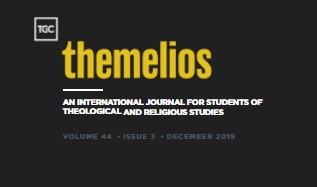Robert Smith: Cultural Marxism: Imaginary Conspiracy or Revolutionary Reality?
 Robert S. Smith, “Cultural Marxism: Imaginary Conspiracy or Revolutionary Reality?” Themelios, 44:3 (2019), pages 436-465.
Robert S. Smith, “Cultural Marxism: Imaginary Conspiracy or Revolutionary Reality?” Themelios, 44:3 (2019), pages 436-465.
I cannot stress enough how important this article is. It should be read by anyone in a Christian leadership position. It is the finest article on the background to the takeover of the America university system by Marxists and radicals that has occurred in the past decades.
The Rev “Rob” Smith is an Anglican priest and lecturer of theology and ethics at Sydney Missionary Bible College, and a book review editor for the e-journal Themelios. It is published for the Evangelical English-speaking world, with contributors from this country, the UK and “down under.”
In his article, Rob Smith sets out to examine the concept of “Cultural Marxism” and determine if the term is useful, if it pertains to a real ideology, or if it is merely a myth invented by conservative activists to negatively broad brush the Left.
He goes about this principally from a historian’s perspective, and rightly affirms that intellectual history is especially difficult, though it is important:
The development of ideas and their links to the movements they generate or justify is often a messy process. It can be notoriously difficult to identify the precise relationship between this school of thought and that social phenomenon or to quantify the impact of particular individuals on larger social changes.
Rob begins his analysis by examining the main components of Karl Marx’s theories (especially useful for those who have not majored in economics or history in college). Rob points out that Marx came from a nominal Christian family and became an atheist as a boy, and never looked back. Not surprisingly, the salient feature of Marx’s theories was his hatred of the bourgeois (the economic middle class). He also developed a reliance on, and then reversed, the philosophy of Hegel. Marx believed that history was driven by materialists factors, not spirit as Hegel believed, and primarily driven by the struggle of the underclasses. Marx believed this would eventually end in a classless Utopia after the bourgeois were violently overthrown. He predicted that communist revolutions would first take place in Europe led by awakened industrial workers. Of course, this did not happen. In Russia and China, the Communist revolution was led by intellectuals and supported mostly by peasants.

Kentaro Toma
Marxist followers tried to make sense of why the industrial workers did not succeed in bringing revolution in Europe and America, and why only a minority were truly radicalized. The answers were worked out by an Italian Communist Antonio Gramsci (1891-1937) who died young but left an extremely influential set of writings. These were done while he was in one of Mussolini’s prison – He had actually supported the fascist Mussolini earlier. Reflecting on his Catholic youth, Gramsci concluded that the reason that prevented workers from becoming communist as Marx had predicted was that the culture was Christian and held on to Judeo-Christian values and ethics. This would always impede and stop the spread of communism. His solution was not a frontal attack on the church, as was happening in Russia, but rather a slow takeover of church institutions and government agencies.
Gramsci’s work was not edited and published in English until 1970, but it circulated among the radical youths of the 1960s and continues to be vastly influential today among radicals and Marxists. The Rev. Smith affirms that after Karl Marx, Antonio Gramsci is the most influential Communist writer of all time. What he advocated has become fact in the American University system, many NGOs, and through “liberation theology” in many parts of the Catholic Church.
This continued advancement of Marxism in the universities and other institutions of America was fueled by a group of Marxist intellectuals that came together at a Communist think-tank in Frankfort, Germany after World War I. They were independent of Stalin’s control, unlike the official Communist parties of the time, and developed different ideas about how to bring about the promised Communist Utopia. The Frankfort group, including Theodore Adorno, Eric Fromm and Herbert Marcuse, fled Germany after the Nazis won power (1933). For a time, they gathered in Columbia University and established the influential Marxist journal, Studies in Philosophy and Social Science. They were careful to be discrete and not overtly call for revolution or cite Karl Marx directly. What they did was develop critical theories of the important institutions of the West, with the intension that if they collapsed internally, or lost authority, the Communist revolution would succeed naturally, and utopia could be gained.
A salient quality of their writings was that they said nothing about the coming Utopia, assuming it would naturally fall into place. Several, including Eric Fromm, attempted to unite Marxist theory with Freudian psychoanalysis. Marcuse did this also, and in his Eros and Civilization: A Philosophical Inquiry into Freud (1955) went to the extreme of suggesting the capitalist bourgeois restrictions on sexuality were what made people unhappy. The liberated person should have no restrictions on sexual expression, including doing what some children do, playing with their own poop. He called this “polymorphous perversity” – a truly demonic idea which invites the spread many parasitic and bacterial diseases. In spite of this, Eros and Civilization became one of the foundations of the sexual liberation movement.
The writings of Gransci and the Frankfort group permeated American and European universities and blended with ecological, feminist, and LGBQ agendas to produce the political correctness movement – which is destroying freedom of speech in the universities. In this regard, Marcuse’s essay, “Repressive Tolerance” (1965) is key, as he suggested there that free speech can be oppressive to the underclasses of society and must be restricted.
The Rev. Smith concludes by identifying Cultural Communism as a real, strong, and active ideology. It is not a myth invented by right-wing activists, nor is it a Jewish plot as some have suggested. Although many in the Frankfort group were indeed Jews, it also had non-Jews. Rather, Cultural Marxism is Marxism elaborated and gone to seed while the West snoozed.
This is a masterful article, concise and insightful. Readers need not have a degree in philosophy or history to understand, though it might be difficult to follow for someone without a college education.
I find the only weak point in his article is the Rev. Smith’s section on how to reverse the present, awful situation in our universities. He advocates pursuing standard evangelistic techniques of conversations and evangelization with the radicals, as in, being polite and listening, and then giving the Gospel. Unfortunately, that has not worked very well. There have been Evangelical groups and clubs at universities for decades, and they have not stopped the universities’ march to radicalization. Traditional evangelism and apologetics has had relatively little impact on non-believers who are saturated with the ideas and myths of Marxism, while the writings of the New Atheists, have widely broadcast distorted and deformed views of Christianity.[1]
What the Rev. Smith is lacking is any understanding in the development that has occurred in recent decades in the area of spiritual warfare. He hints that some of the success of the Cultural Marxism may be due to demonic influences, but does not elaborate on this.
In this regard, I am preparing an essay which suggests that to counter Cultural Marxism it is necessary to massively employ spiritual warfare techniques and strategies, as in “concerts of prayer” that war against the territorial “principalities and powers” that reign over universities. Decades ago, the missiologist Peter Wagner showed this could be done to bind the demonic spirits that held back effective evangelization in the areas that resisted the Gospel.[2] To this type of spiritual warfare[3] should be added the “power evangelism” technique for individual evangelization made popular by John Wimber.[4] Indeed, radicalized individuals will not be swayed by evangelistic tracts or Billy Graham type crusades. Their deep contempt for Christianity makes them resistant to those forms of evangelization. But they will respond to the Gospel if it is presented, as scripturally mandated, with “signs and wonders,” as in their own healings (Heb 2:1-4). Power evangelism might best be brought to the universities through the “public prayer stations” where intercessors are posted on the streets to offer prayer to pedestrians. Even radicals have personal needs (“I’m sick,” “My girlfriend left me,” etc.) and are often willing to try prayer.[5]
Reviewed by William De Arteaga
Notes
[1] Siniscalchi, Glenn B., “Evangelization and the New Atheism,” American Theological Inquiry, 2 no 2 Jul 15 2009, p 29-41
[2] Peter Wagner has written many books and articles, but perhaps the two most pertinent in praying for the universities and colleges are: C. Peter Wagner, ed., Territorial Spirits: How to Crush the Enemy Through Spiritual Warfare (Shippensbury: Destiny Image, 2012) and Confronting the Powers (Regal, 1996)
[3] [Editor’s note: For a counter-point to the discussion of strategic level spiritual warfare, please see Larry Taylor, “Worldviews in Conflict: Christian Cosmology and the Recent Doctrine of Spiritual Mapping” Pneuma Review (Part 1 in Fall 2001 and Part 2 in Winter 2002).]
[4] John Wimber and Keven Springer, Power Evangelism (San Francisco: Harper Collins, 1987).
[5] William L. De Arteaga, The Public Prayer Station: Taking Healing Prayer to the Streets and Evangelizing the Nones (Lexington: Emeth Press, 2018). Note the rapid conversion of a dedicated atheist during a prayer station healing, p. 62.
Category: Fall 2020, Living the Faith


